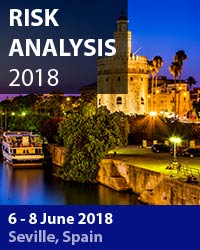Risk Analysis 2018
11th International Conference on Risk Analysis and Hazard Mitigation
![]()
6 - 8 June 2018
Seville, Spain
Overview

The 11th International Conference on Risk Analysis and Hazard Mitigation was held in Seville, Spain organised by Wessex Institute, represented by Prof Stefano Mambretti, and the University of Milano-Bicocca, represented by Dr Andrea Fabbri. The meeting was sponsored by WIT Transactions on Engineering Sciences and the International Journal of Safety and Security Engineering.
Seville is the capital of the Andalusia region and is situated on the river Guadalquivir. The city is more than 2,200 years old and has a distinct personality and a large and well-preserved historical centre. The old town contains three world heritage sites: the Minaret of La Giralda, the General Archive of the Indies and the Alcázar Palace. The city is also home to many convents, churches, palaces, museums and gardens including the Museum of Fine Arts, Parque de María Luisa and the Gothic Cathedral which is the site of Christopher Columbus’s tomb. It is believed that flamenco originated in Seville, and there are many flamenco shows on offer all over the city, as well as the museum dedicated to the art.
The conference covered a series of important topics of current research interests and many practical applications. This concerned all aspects of risk management and hazard mitigation, associated with both natural and anthropogenic hazards.
Current events helped to emphasise the importance of the analysis and management of risk to planners and researchers around the world. Natural hazards such as floods, earthquakes, landslides, fires and others have always affected human societies. The more recent emergence of the importance of man-made hazards is a consequence of the rapid technological advances made in the last few centuries. The interaction of natural and anthropogenic risks adds to the complexity of the problems.
All the papers presented at the Risk Conference are archived in the WIT eLibrary (https://www.witpress.com/elibrary), where they are immediately and permanently available to the international scientific community.
Opening of the Conference
The meeting was opened by Prof Stefano Mambretti, a member of the Board of Directors of the Wessex Institute. Stefano paid tribute to the founder of Wessex Institute, the late Prof Carlos Brebbia who was a gifted academic, renowned throughout the world as the originator of the Boundary Element Method. He was very proud of WIT’s successful conference programme which disseminates advanced knowledge worldwide.
In addition to conferences and courses, the Institute has a very active publication programme which covers papers presented at conferences, those published in Journals and specialised books. The conferences are held in different locations around the world.
WIT is actively involved in industrial research and collaborating with industry. This has led to the continuing development of a unique software system based on the Boundary Element Method, a technique which can be applied to solve a wide variety of problems. This led to the Institute becoming involved in a large series of interdisciplinary projects, some of which were described by Stefano, who stressed the commitment of WIT to collaborate with other organisations.
Keynote Address
Dr Andrea Fabbri then welcomed the delegates to the conference and gave a keynote address entitled “How credible is my hazard map? Dissecting a prediction pattern of landslide susceptibility”.
A hazard map was used to represent the likelihood of future occurrences of hazardous events. Predicting the future, however, is far from easy and prone to uncertainty, misunderstanding and suspicion. This contribution presented a landslide-susceptibility prediction pattern that resembled a map but is a complex construction resulting from modelling and assumptions imposed on historical data. A mathematical model of spatial relationships, based on fuzzy sets was applied to a spatial database that was constructed for landslide susceptibility studies in northern Italy. The model considered a pixel in a study area using the following proposition, “Tp: p would be affected by a future landslide of a distinct dynamic type.” At pixel p there was information of spatial evidence and a function was defined at every p that represented the degree of support of the proposition that p was likely to be affected by future landslides given the evidence. Such a function, termed favourability function, was interpreted as a fuzzy set membership function.
The resulting prediction pattern was dissected into its basic components to bring up the implied elements of spatial characterization, relevance of thematic input, assumptions in models and data, and visualization/interpretation of predicted scores. By the term prediction pattern the result of the classification of the study area into levels of relative susceptibility was indicated. The integrated predicted scores for each pixel range between 0 and 1 were computed with 4-byte numerical precision. As such, they could not be easily interpreted. They were then sorted in descending order between the maximum and the minimum and 200 was a fixed number of equal area ranks used to replace the scores. Each rank corresponded to the 0.5% of the study area. The prediction pattern consisted of an image with pixel values that ranged between 1 and 200.
Of particular relevance within the study area was the uncertainty associated with the scores, i.e., the ranks that classified the zones that were relatively more susceptible. Such a dissection of prediction pattern led to a confirmation of the credibility of the prediction pattern (hazard map?) based on the confidence gained by the comprehension of all elements integrated and assumptions made in its construction. For instance, in the database partitions of the supporting patterns, i.e., the spatial evidence, enabled to verify its consistency by cross-validations. Furthermore, the effectiveness of the ranks in the prediction pattern was expressed by prediction rank histograms and cumulative curves. Even the prediction scores of individual landslide occurrences became informative of the distinctiveness of their presence within the study area. Many of the aspects discussed in this contribution are frequently ignored or hidden in hazard and risk studies.
Invited Speakers
The conference was enhanced by a series of invited papers, as follows:
- “Modelling of hydrocarbon gas and liquid leaks from pressurized process systems”, by Amaranath Sena Kumara, Lloyd’s Register Consulting – Energy AS, Norway.
- “The risk atlas of Mexico City, Mexico”, by David Novelo-Casanova, Universidad Nacional Autonoma de Mexico, Mexico.
- “Infrastructure based approach to increase cycling safety in case of turning cyclists interacting with crossing motorists at an urban intersection”, by Marek Junghans, German Aerospace Centre, Germany.
- “Large-scale fire risk planning for initial attack and fuels: the US state of Idaho”, by Douglas Rideout, Colorado State University, USA.
- “Modelling of future flood risk across Canada under climate change”, by Slobodan Simonovic, Western University, Canada.
- “Oil Spill Risk Analysis in the Gulf of Mexico”, by Jeff Ji, Bureau of Ocean Energy Management, United States of America.
Conference Dinner
The Conference Dinner took place at El Patio Sevillano, a place that combines a restaurant and a flamenco music show. Thus the delegates, in addition to tasting typical Andalucian gastronomy, enjoyed a performance with singers, guitar players and flamenco dancers, comprised of a group of 20 people on stage. The quality of the show and the friendly atmosphere helped to strengthen links among the conference delegates.
The International Scientific Advisory Committee met over dinner to discuss how the meeting could be improved in 2020. Several new topics were discussed as well as the nominations of colleagues to join the Committee. There was general agreement of the importance to find ways in which delegates could interact more outside the conference sessions. The Conference Division of WIT will investigate suitable venues.
Closing of the Conference
The Conference was closed by Stefano and Andrea who expressed WIT’s gratitude to all participants for their contributions.
Related Conferences:
ERES 2019, 5 - 7 June 2019
SAFE 2019, 23 – 25 September, 2019
Disaster Management 2019, 25 – 27 September 2019



 Wessex Institute
Wessex Institute